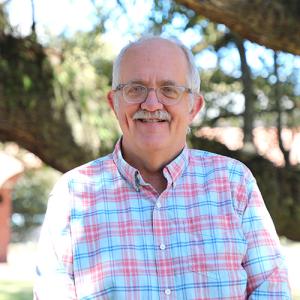Paul Leberg

- Faculty
- Associate Dean of the Graduate School
- Department Head
- John E. and Joretta A. Chance Endowed Professor of Biology
- 337-482-2500 x26637
- paul.leberg@louisiana.edu
- Billeaud Hall, Room 142
Biography
Dr. Paul Leberg's special interests are in the application of theory from ecology, evolution, and population genetics to questions in wildlife management and conservation biology. Dr. Leberg's work employs experimental approaches to gain understanding of interactions between genetic diversity, environmental variation, and population viability under natural conditions. Students in Dr. Leberg's laboratory are evaluating how well theory and laboratory observations involving founder effects, bottlenecks, inbreeding, and outbreeding predict viability of experimental populations of vertebrates. They are also assessing how genetic diversity on population level processes is affected by fluctuating and stressful environments. Environmental stresses include parasitism, competition, predation, heavy metals, temperature, and salinity. This research adds to their understanding of how genetic variation influences a population's ability to survive in the face of biotic and abiotic threats and provides insight into the management of vertebrates in small populations and the restoration of species to areas from which they have been extirpated.
Dr. Leberg's research interests also include the effects of human activities on the genetics, evolution, and ecology of vertebrates. Genetic diversity is assessed in wildlife species whose population structures have been altered by humans, and in experimentally manipulated populations maintained in simulated natural conditions. As part of this work, Dr. Leberg is evaluating the relative power of different biochemical and molecular techniques to assess variation in genetic diversity within and among populations, as well as to serve as tags for the study of individual movement and estimation of population size. Dr. Leberg and his students are also examining the effects of habitat change, such as wetland loss and forest alteration, on a diverse group of vertebrates including fish, seabirds, songbirds, and bats.
Dr. Leberg also has considerable administrative experience, including graduate coordinator in Biology, Department Head of Biology, and Associate Dean of the Graduate School (current)
Education
Ph.D. in Ecology, 1990
University of Georgia
M.S. in Biology, 1985
University of Memphis
B.S. in Wildlife and Biology, 1982
University of Wisconsin, Stevens Point
Student Research/Collaboration
- Environmental Biology
- Conservation Biology
- Ecology, Biometrics
- Molecular Ecology
- Coastal Ecology and restoration
- Biotic Consequences of Climate Variation
Opportunities for Student Research/Collaboration:
Field and laboratory work in association with Graduate Student research in coastal Louisiana
Publications
- Hucks, K. and P.L Leberg. 2024. Evaluation of Maximum Entropy Models for Assessing Coastal Bird Distributions Under Restoration Scenarios,Journal of Coastal Research. 40(5):901-918. https://doi.org/10.2112/JCOASTRES-D-23-00098.1
- Byerly, P.A, S. Zaluski, D. Nellis, J. Piece, and P.L. Leberg 2023. Current status and 21st century population trends of breeding seabirds in the U.S. and British Virgin Islands. Journal of Caribbean Ornithology. 36:126-134.
- Byerly, P.A, R. T. Chesser, R. C. Fleischer 4 , N. McInerney, N. A. S. Przelomska, and P.L. Leberg 2023. Conservation genomics reveals low connectivity among populations of threatened roseate terns (Sterna dougallii) in the Atlantic Basin. Conservation Genetics https://doi.org/10.1007/s10592-023-01505-6
- Byerly, P.A, R. T. Chesser, R. C. Fleischer 4 , N. McInerney, N. A. S. Przelomska, and P.L. Leberg 2022. Museum genomics provide evidence for persistent genetic differentiation in a threatened seabird species in the Western Atlantic. Integrative and Comparative Biology
- Byerly, P.A, S. Zaluski, D. Nellis, and P.L. Leberg 2022. Effects of Colony Disturbance on Reproductive Success and Nest Defense Behaviors in Caribbean Roseate Terns. Waterbirds in press.
- Jones, LR, E. Godollei, , A Sosa, K Hucks, ST Walter, PL Leberg, and J. Spring. 2021. Validating an unmanned aerial vehicle (UAV) approach to survey colonial waterbirds. Waterbirds, 43, 263-270. doi.org/10.1675/063.043.0304
- Hauser, S. S., Athrey, G., & Leberg, P. L. 2021. Waste not, want not: Microsatellites remain an economical and informative technology for conservation genetics. Ecology and Evolution, 11, 15800–15814. doi. org/10.1002/ece3.8250
- Byerly, P.A, S. Zaluski, D. Nellis, and P.L. Leberg 2021. Colony characteristics influence nest survival of Caribbean Roseate Terns. Ornithological Applications, 123: doi.org/10.1093/ornithapp/duaa069
- Hauser S., and P.L. Leberg P. 2020. Riparian areas potentially provide crucial corridors through fragmented landscape for black-capped vireo (Vireo atricapilla) source-sink system. Conservation Genetics, 22:1-10.
- Byerly, P.A, H. Waddle, A. Romero Premeaux, and P.L. Leberg. 2020. Effects of barrier island salt marsh restoration on marsh bird occurrence in the Northern Gulf of Mexico. Restoration Ecology. https://doi.org/10.1111/rec.13222
- Geary, B., S.T. Walter, P.L. Leberg, J. Karubian. 2020. Breeding Brown Pelicans improve foraging performance as energetic needs rise. In press, Scientific Reports. Doi: 10.1038/s41598-020-58528-z
- Klerks P.L,, G.N. Athrey, and P.L. Leberg 2019. Response to Selection for Increased Heat Tolerance in a Small Fish Species, With the Response Decreased by a Population Bottleneck. Front. Ecol. Evol. 7:270. doi: 10.3389/fevo.2019.00270
Awards & Recognition
- 2012-present John Chance Board of Regents Support Fund Professorship, University of Louisiana
- 2007 Foundation Distinguished Professor, University of Louisiana Foundation
- 2006-2012 Fritz Lang Board of Regents Support Fund Professorship in Environmental Biology, University of Louisiana